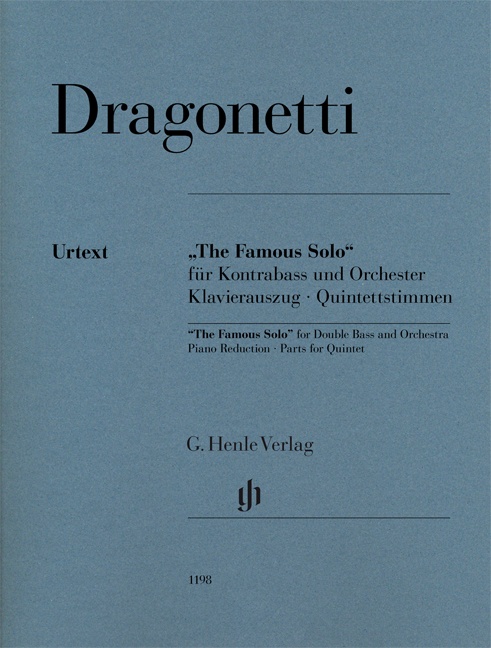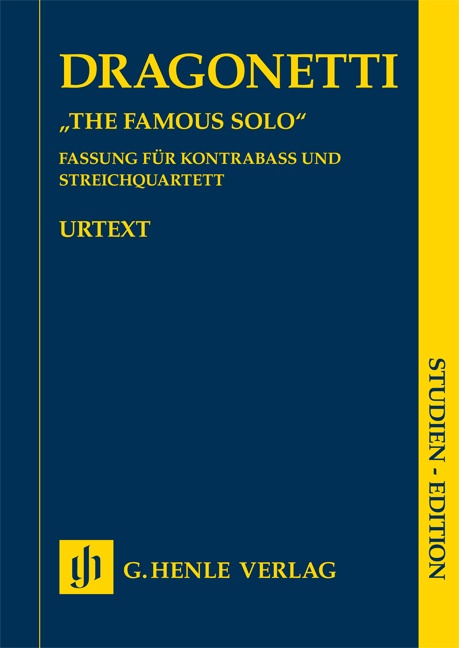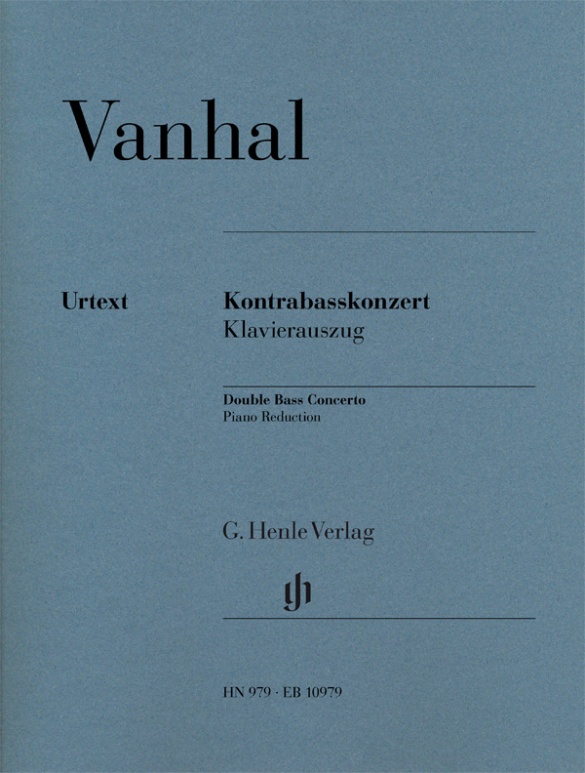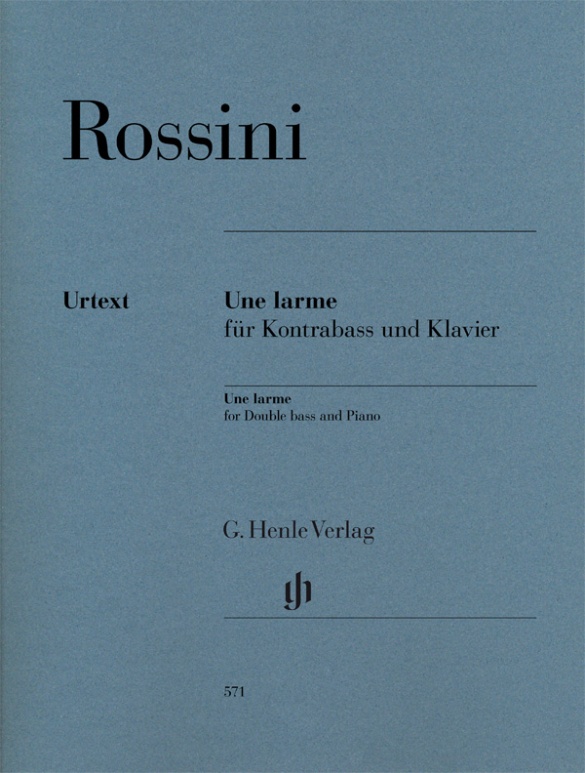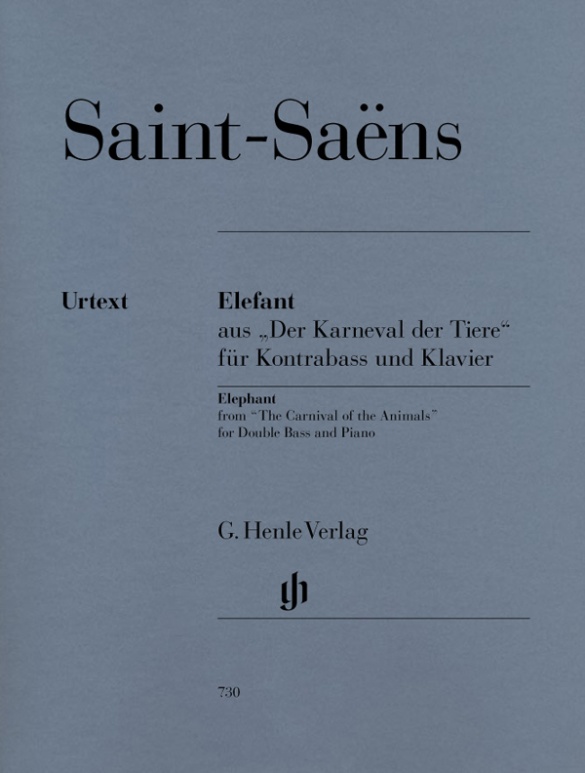

Camille Saint-Saëns
Elephant from “The Carnival of the Animals” for Double Bass and Piano
This "hit", the Elephant from "The Carnival of the Animals" for Double Bass and Piano, is one of the few double bass compositions attractive to learners and seasoned musicians alike, now appears in a Henle urtext edition for double bass in solo and orchestral tuning, with piano parts in F major and E flat major.
Content/Details
About the Composer
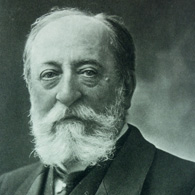
Camille Saint-Saëns
Saint-Saëns was one of the most multifaceted musicians of the second half of the nineteenth century in France. Regarded as a Classicist, he also wrote pieces with an Impressionist character to their sound, and one composition in quarter-tones. As a critic and essayist he was involved in the first complete editions of Rameau’s and Gluck’s works.
| 1835 | Born in Paris on October 9. Early comprehensive education. |
| 1848–52 | Studies at the Conservatoire de Paris. |
| 1853 | Organist at St. Merry Church in Paris. |
| 1853–59 | First large-scale works: Symphony No. 1, Op. 2 (1853), and No. 2, Op. 55 (1859); Piano Concerto No. 1, Op. 17 (1858); Violin Concerto No. 1, Op. 20 (1859); Mass, Op. 4 (1856); he attempts to arrive at unique forms. |
| 1857–77 | Organist at La Madeleine in Paris. |
| 1861–65 | He teaches at the École de Musique Classique et Religieuse Niedermeyer. |
| 1871 | Founding of the Société Nationale de musique. |
| 1871–77 | Composition of symphonic poems “Le rouet d’Omphale” (“The Wheel of Omphale,” 1871), “Phaéton” (1873), “Danse macabre” (1874), “La jeunesse d’Hercule” (1877). |
| 1876 | Attends the performance of the Ring in Bayreuth. |
| 1877 | Performance in Weimar of his opera “Samson et Dalila.” |
| 1881 | Member of the Académie des Beaux-Arts. |
| 1883 | Performance in Paris of his opera “Henry VIII.” |
| 1885 | Publication of the treatise “Harmonie et mélodie.” |
| 1886 | Performance in London of his Organ Symphony (Symphony No. 3 in C minor): major work with thematic transformation after Liszt’s model. Composition of “The Carnival of the Animals,” the publication of which he forbade during his lifetime. |
| 1899 | Publication of the book “Portraits et souvenirs.” |
| 1900 | Cantata “Le feu celeste” in praise of electricity, for the opening of the Exposition Universelle. |
| 1921 | Death in Algiers on December 16. |
About the Authors
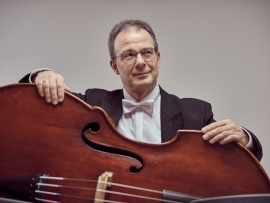
Tobias Glöckler (Editor, Fingering and bowing for Double Bass)
Tobias Glöckler is associate principal double bass player at the Dresdner Philharmonie and a prizewinner of the International ISB Double Bass Competition (USA). He studied with Konrad Siebach at the Music Conservatory in Leipzig, perfecting his skills with Jeff Bradetich (Chicago) and Ulrich Lau (Stuttgart). While studying, he was principal double bass player with the International Gustav Mahler Youth Orchestra under Claudio Abbado. He has performed as a soloist with different orchestras, including the Dresdner Philharmonie with Ton Koopman. In addition he has made recordings for radio and has made guest appearances at diverse music festivals. He is a founding member of and solo bass player with the “ensemble frauenkirche” and has explored a great many chamber music works with the Dresdner String Quintet.
Glöckler teaches at the music conservatory in Dresden. His efforts concerning the revival of the “Viennese Tuning” have been rewarded with a Distinguished Achievement Award for historical performance practice.
Photo © markenfotografie
Product Safety Informations (GPSR)

G. Henle Verlag
Here you can find the information about the manufacturer of the product.G. Henle Verlag e.K.
Forstenrieder Allee 122
81476 München
Germany
info@henle.de
www.henle.com
Most of us have played this well known piece of the bass repertoire. For those who haven’t, this edition with its preface is certainly the most rewarding own.
Double Bassist, 2002… that this is a very nice edition – beautifully printed on a good quality paper and programme notes that will be rifled by many an intermediate bassist. Recommended.
Bass News, 2002recommendations
autogenerated_cross_selling
Further editions of this title
Further editions of this title


